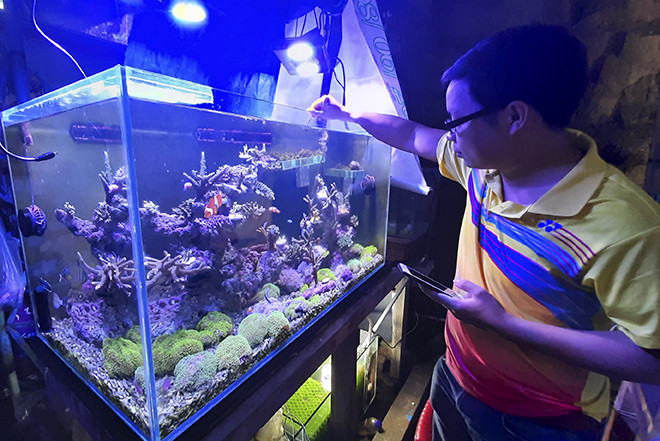
In order to artificially breed corals and reduce pressure on coral reed resources in the wild, over 1 year, Scientist Doan Van Than, 29, the Division of Aquaculture Techniques, Museum of Oceanography, Institute of Oceanography (Nha Trang City) has made many dives in Nha Trang Bay to get coral samples for research and artificial breeding...
In order to artificially breed corals and reduce pressure on coral reed resources in the wild, over 1 year, Scientist Doan Van Than, 29, the Division of Aquaculture Techniques, Museum of Oceanography, Institute of Oceanography (Nha Trang City) has made many dives in Nha Trang Bay to get coral samples for research and artificial breeding.
Doan Van Than is a young scientist working at the Exhibit Room for Marine Resources of the Spratly and Paracel Archipelagoes. He is also a diver during research trips made by the Institute of Oceanography. Diving in Nha Trang Bay, he felt so sorry when seeing beautiful corals damaged and dying out due to many factors, including marine pollution, weather and human activities. Through coral survey trips for research, he cherished a dream to breed corals in artificial environments.

|
Receiving approval and funding from the institute to buy filter tanks, breeding tanks, lighting, air-conditioners, water coolers, etc, he started his research on breeding corals. There are 3 types of corals known as soft, horny and hard corals. He chose the hard one as this is the most difficult coral to be bred.
Currently, there are 8 kinds of hard corals and 6 kinds of soft ones in his coral reef tanks. He brought some dead coral fragments from his diving trips and transplanted them to rocks in his tanks. He says the most difficult thing in breeding corals is to keep water clean and amounts of substances in water stable. Not having much knowledge about coral breeding, he started to learn more from books and search on the Internet. In the first month, he spent all days watching and measuring amounts of substances in tanks to make sure proper nutrients for breeding corals. He also added some coral reef fish, the urine of which gives essential nutrients for the growth of corals in his coral tanks.
After one year collecting samples and conducting research, his artificial corals including 8 kinds of hard corals and 6 kinds of soft ones, are growing. “This is a basis for my further research on artificial breeding of corals that I have cherished for so long. In addition, the development of corals has also added attraction to coral exhibits at the Institute of Oceanography to serve sightseeing tours integrated with marine environmental protection,” he eagerly shared his ideas.
Corals on display at the institute are from natural environments. However, the institute is turning towards artificial breeding of corals instead of taking them from the wild for exhibit purposes. Therefore, the institute has encouraged staff in the Division of Aquaculture Techniques to keep on learning more to widen knowledge for coral development. The artificial breeding is applied for not only corals but also other marine species to minimize exploitation from the nature, according to PhD. Hoang Xuan Ben, Deputy Director of the Institute of Oceanography.
Thai Thinh
Translated by N.T






